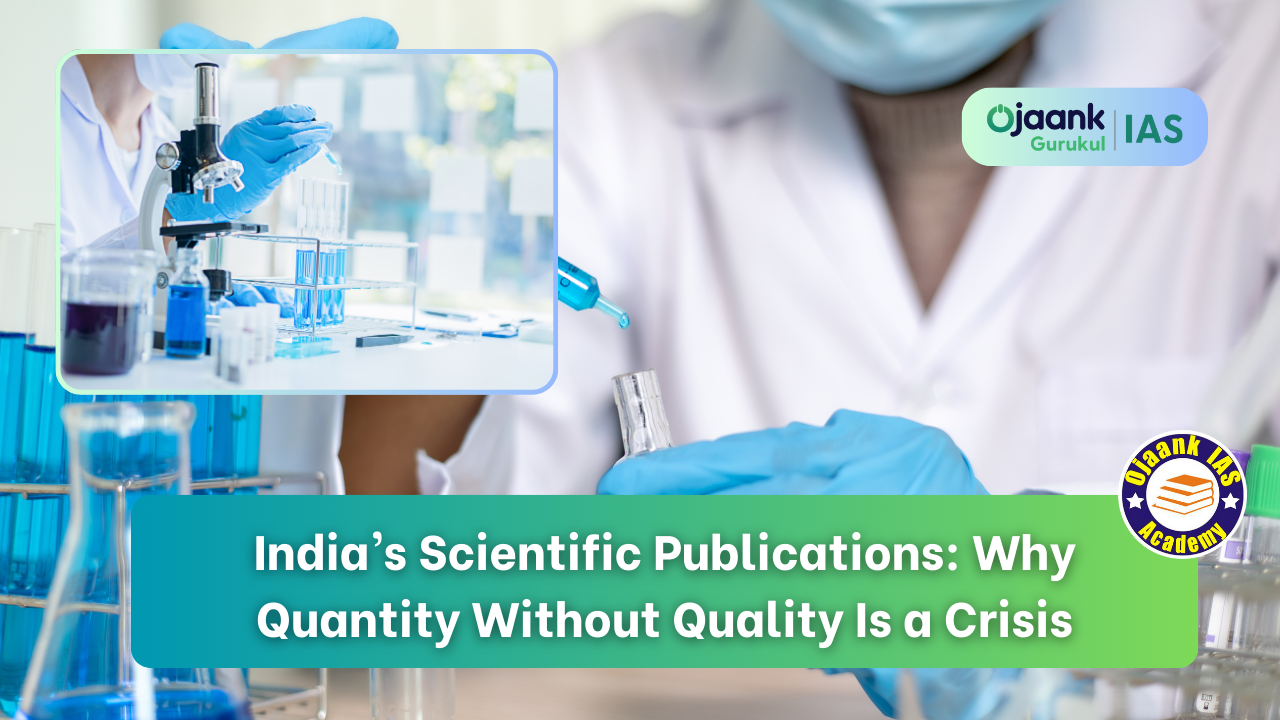India’s Scientific Publications: Why Quantity Without Quality Is a Crisis

 India’s Scientific Publications: A Race for Quantity, A Crisis of Quality
India’s Scientific Publications: A Race for Quantity, A Crisis of Quality
India is sprinting towards becoming a global leader in scientific output. With projections claiming the country will overtake the United States in publication volume by 2029, there’s an air of triumph in official circles. But dig a little deeper, and the picture isn't just flawed — it's alarming.
Despite rising numbers, the quality of India’s scientific research is under serious scrutiny. The challenge isn’t just about producing more papers; it’s about producing meaningful, ethical, and impactful research that stands the test of global standards.
🌐 Read: India's Scientific Research: Quantity vs. Quality – Nature article analyzing the growing quantity of India's research publications and the concerns over quality.
 The Numbers Game: Illusion vs. Reality
The Numbers Game: Illusion vs. Reality
At a recent National Science Day function, India’s Union Science Minister boasted about the country closing in on the U.S. in terms of the number of research publications. Based on raw figures, India had 2,07,390 papers in 2024 compared to the U.S.'s 4,57,335. China leads with over 8,98,949 publications.
But here’s the catch: quantity doesn’t equal quality.
 CNCI — The Real Quality Benchmark
CNCI — The Real Quality Benchmark
The Category Normalized Citation Impact (CNCI) gives us a clearer picture:
-
India: 0.879
-
China: 1.12
-
USA: 1.25
Out of 30 top publishing nations, India ranks 28th in research quality. That’s a wake-up call.
🌐 Explore: Category Normalized Citation Impact (CNCI) Explained – Clarivate’s detailed explanation of CNCI and how it measures research quality.
 Science Needs Investment, Not Just Intention
Science Needs Investment, Not Just Intention
Let’s talk numbers where they matter — investment in civilian R&D as a percentage of GDP:
-
Israel: 6.3%
-
South Korea: 4.9%
-
USA: 3.46%
-
China: 2.4%
-
India: Just 0.67%
If “Viksit Bharat 2047” is the goal, this level of investment is not just insufficient — it's delusional. You can’t build a knowledge economy on slogans and token documents.
🌐 Read: Global R&D Spending by Country – OECD data on R&D expenditure as a percentage of GDP by leading nations.
 India vs. The World: A Deep Dive into Journal Impact
India vs. The World: A Deep Dive into Journal Impact
Consider the Journal of the American Chemical Society (JACS) — one of the world’s most respected chemistry journals:
-
Chinese Academy of Sciences: 444 papers
-
All CSIR labs in India: Just 29
-
All IITs combined: 68 papers (2017–2024)
Even mid-tier Chinese universities are publishing more and in better journals than India’s top institutions. Our research strength fades when placed against serious metrics like Impact Factor or the H-Index of contributing scientists.
 The Ethics Crisis: Fake Journals and Fraudulent Science
The Ethics Crisis: Fake Journals and Fraudulent Science
India faces a deeper malaise: questionable ethics and outright fraud in scientific publishing.
-
A 2018 study found that 62% of the world’s fake standalone journals come from India.
-
Around 10% of India’s total research output may be fake.
-
The infamous Omics Group, fined $50 million by the U.S. FTC in 2019, published 69,000 deceptive papers, polluting global scientific literature.
The reason? Perverse incentives. Researchers are pushed to hit publication quotas instead of pursuing quality or innovation, and the system rewards volume over value.
 Delusional Comfort and Institutional Narcissism
Delusional Comfort and Institutional Narcissism
India’s top science officials continue to spin misleading narratives — like celebrating the inclusion of 5,351 Indian scientists in the world’s “top 2%” list, without revealing that rankings range from 163 to over 6 million.
Such chest-thumping is not just tone-deaf — it's actively harmful. It hides the truth and obstructs reform.
🌐 Read: India’s Scientists in the “Top 2%” List: The Real Numbers – Stanford University article explaining the methodology behind the top 2% scientist rankings.
 The Way Forward: Fixing India’s Science Ecosystem
The Way Forward: Fixing India’s Science Ecosystem
-
Massive investment in public universities and science labs — especially outside metro hubs.
-
Overhaul incentives to reward innovation and real impact, not just paper count.
-
Crack down on fake journals and unethical publication practices with legislation and peer accountability.
-
Global benchmarking of all publicly funded research using citation indices and impact factors.
-
Encourage international collaboration and exposure to global research ecosystems.
🌐 Learn more: Global Research Collaboration Trends – Nature report on the benefits of international collaboration in scientific research.
 Final Thoughts: What Counts Can’t Always Be Counted
Final Thoughts: What Counts Can’t Always Be Counted
India’s future as a knowledge power depends not on how many papers we publish, but on how many matter. As Einstein said:
“Not everything that can be counted counts. Not everything that counts can be counted.”
We need to stop measuring progress in vanity metrics and start building a foundation of trustworthy, transformative research. Only then can we claim the title of a true research powerhouse.
🌐 Read: How to Measure Scientific Research Impact – Science Magazine article discussing the complexities of measuring research quality beyond publication count.